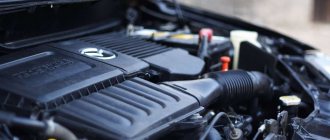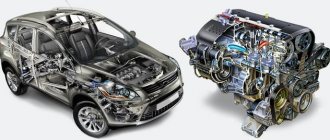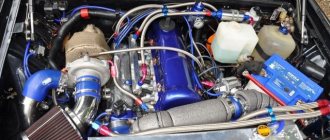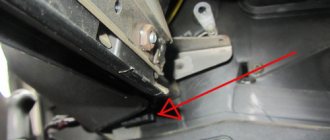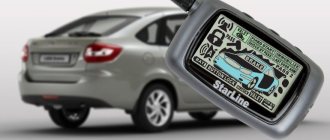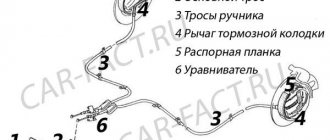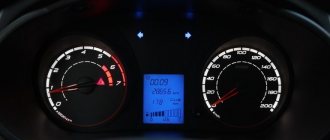About modern VAZ engines
The manufacturer offers a choice of two 8 valve engines :
- VAZ-11183-50 (82 hp) is a modified VAZ-2111 engine, as a result of which environmental performance has increased, the engine has become more reliable and less capricious. It also has the advantage of elasticity and traction. Disadvantages include periodic valve adjustments and noisy engine operation. If the timing belt breaks, the valve does not bend.
- VAZ-11186 (87 hp) is a modified VAZ-21114 engine, as a result of which it was possible to reduce noise and gasoline consumption. Environmental friendliness has improved and power has increased noticeably. Disadvantages: compared to the VAZ-11183, this engine has a shorter service life. When the timing belt breaks, the valves bend.
16 valve engines :
- VAZ-21126 (98 hp) is a continuation of the VAZ-21124 engine and is currently one of the most advanced domestic engines. Disadvantage: valve bends when the timing belt breaks.
- VAZ-21127 (106 hp) is a modified VAZ-21126 engine. In comparison, the engine has become more torquey at the bottom, the changes are minor, but noticeable. The disadvantages include bending of the valves when the timing belt breaks.
8 valve engines
Unlike 16 valves, a single-shaft gas distribution system is used here. There are two valves for each cylinder: intake and exhaust. Such engines are reliable and do not bend valves when the timing belt breaks, but are significantly inferior in the dynamic performance of the vehicle, as well as in the noise level of the internal combustion engine.
Engine VAZ 11183
This engine was installed not only on Grants, but also on the last 2114 years of production. The engine is quite noisy and requires frequent valve adjustment due to the lack of hydraulic compensators. 183 the engine does not bend the valve when the timing belt breaks. This is the only engine installed on the Grant that is not afraid of timing belt breakage.
Technical characteristics of VAZ 11183:
| Fuel supply | Injector |
| Number of cylinders | 4 |
| Number of valves | 8 |
| Compression ratio | 10 |
| Power (hp) | 82 |
| Engine capacity (cc. cm) | 1596 |
| Required fuel | Not lower than AI 95 |
| Torque (N*m) | 120 |
Engine VAZ 21116/11186 1.6l. 87hp
In this article we’ll talk about the “Grant” engine 11186 or 21116, which replaced the 21114 engine from the VAZ 2114. Let's talk about the advantages and disadvantages compared to the previous generation.
Specifications
Start of production – 2011 to the present day. Appeared for the first time on Grant in the same 2011.
Cylinder block - cast iron
Power system – injector, e-gas (electronic gas pedal)
4 cylinders, 8 valves, in-line. Piston stroke – 75.6 mm; Cylinder diameter – 82mm. Engine capacity 11186/21116 –1.6l. Engine power 11186/21116 – 87 hp. /5100 rpm Torque - 140 Nm / 3800 rpm Fuel - AI95 Fuel consumption - city 8.6 l. | track 5.8 l. | funny 7.3 l/100 km
Description of engine 11186/21116
"Grant" engine power 87 hp. is a modified engine 21114 from Lada Samara. The difference between Grant's and its predecessor is the use of a Prioro-piston and Prioro cylinder block. The rest of the filling remains unchanged.
Main engines
As the main engines, AvtoVAZ offers customers a choice of the power units already mentioned just above. Let's talk about each of them separately.
VAZ-11183-50
The eight-valve VAZ-11183-50 engine is an improved VAZ-2111 with a power of 82 hp, which is installed on Grant sedans and hatchbacks. The work carried out to improve the unit has increased its environmental friendliness and reliability, the level of engine torque and its elasticity have significantly increased.
The disadvantages of the VAZ-11183-50 include increased noise and the need to adjust the valves from time to time. In addition, this motor may not warm up to the required temperature due to a malfunction of the thermostat (the thermostat in such a situation must be replaced).
In addition, instability in the operation of the motor is often observed, for which there may be several reasons. For example, such instability is often associated with the burnout of one of the valves, with a violation of the integrity of the gasket, or with a malfunction of the ignition module. However, bending of the valves due to a broken timing belt will not occur.
| Number of cylinders: | 4 |
| Cylinder displacement, l: | 1,596 |
| Compression ratio: | 9,6-10 |
| Rated engine power at a crankshaft speed of 5200 rpm: | 60 kW.-(82 hp.) |
| Cylinder diameter, mm: | 82 |
| Piston stroke, mm: | 75,6 |
| Number of valves: | 8 |
| Minimum crankshaft speed, rpm: | 800 — 850 |
| Maximum torque at 2500-2700 rpm, N*m: | 120 |
| Cylinder operating order: | 1-3-4-2 |
| Octane number of gasoline: | 95 (unleaded) |
| Fuel supply system: | Electronically controlled distributed injection |
| Spark plug: | A17DVRM, BPR6ES(NGK) |
| Weight, kg: | 112 |
VAZ-11186 (VAZ 21116)
VAZ 21116 is another representative of eight-valve engines with 87 hp. under the hood. It is a modified and improved VAZ-21114 engine, which is distinguished by a lower noise level and noticeable fuel economy. They are equipped with Grant's Norma vehicles.
If we compare the VAZ 21116 with the VAZ-21114, we should note a noticeably increased level of environmental friendliness, and the power has also increased significantly. The disadvantages of the engine include a more modest resource than, for example, that of the VAZ-11183. Its pistons are much lighter than those of its predecessor, but this circumstance led to the appearance of two more disadvantages.
Lada Granta 21116 engine life, maintenance, pros and cons
The Lada Granta 21116 engine model under consideration differs from its predecessors in sufficient reliability and efficiency. If you take into account compliance with the operating and maintenance conditions (time frames for maintenance), you can significantly extend the service life of the unit.
Features of servicing the VAZ 21116 engine:
- The engine oil and oil filter are replaced every 15 thousand kilometers (recommended by the manufacturer);
- mandatory adjustment of valve clearances and replacement of the valve cover gasket;
- replacing spark plugs, air and fuel filters after 30 thousand kilometers;
- after a run of 90 thousand kilometers, they change the coolant, drive belts, high-voltage wires, etc.
Fuel consumption per 100 km, even when driving in city traffic (traffic jams, traffic lights), usually does not exceed 10 liters. By the way, the use of AI-95 fuel recommended by the manufacturer can reduce fuel consumption even further.
You can also note the normal start of the engine in cold weather, even after the car has been idle for a long time. Also a plus is a reduction in noise (minimal vibration) and an increase in the torque of the internal combustion engine.
The only drawback is a broken engine timing belt, which leads to bending of the valves (as a result, expensive repairs). Also, in some cases, the fragility of the pistons is noted (when they collide with the valves, they sometimes break and require replacement much earlier than their allotted time);
Characteristics of motor 11186
The project of a “people's car” at a budget price for the average LowCost user was seriously hampered by the economic crisis. For the Lada Granta Standard configuration, the technical characteristics of the existing ICE 11183 were sufficient.
However, for the Norma and Lux trim levels, a more powerful internal combustion engine was needed, so the management of AvtoVAZ, not having sufficient funding for the project of a new engine, came out of the situation as follows:
- the existing version 21114 became the basis for the ICE 11186;
- to reduce costs, pistons from the American manufacturer Federal Mogul were replaced with domestic products of a suitable size;
- The manufacturer changed the engine markings, but no more design changes were made.
Unlike 11183, the piston of the 11186 motor bends the valve when the timing belt breaks, but the performance characteristics are improved:
| Manufacturer | AvtoVAZ |
| Engine brand | 11186 |
| Years of production | 2011 – … |
| Volume | 1598 cm 3 (1.6 l) |
| Power | 64.2 kW (87 hp) |
| Torque moment | 140 Nm (at 3800 rpm) |
| Weight | 140 kg |
| Compression ratio | 10,5 |
| Nutrition | injector |
| Motor type | in-line |
| Injection | electronic multipoint |
| Ignition | the electronic unit |
| Number of cylinders | 4 |
| Location of the first cylinder | TVE |
| Number of valves on each cylinder | 4 |
| Cylinder head material | aluminum alloy |
| Intake manifold | plastic receiver, electronic throttle |
| An exhaust manifold | combined with catalyst |
| Camshaft | from 11183 |
| Cylinder block material | cast iron |
| Cylinder diameter | 82 |
| Pistons | lightweight |
| Crankshaft | ductile iron, oil channels |
| Number of main bearings | 5 |
| Piston stroke | 75.6 mm |
| Fuel | AI-95 |
| Environmental standards | Euro 4 |
| Fuel consumption | highway – 5.7 l/100 km combined cycle 7.3 l/100 km city – 8.5 l/100 km |
| Oil consumption | maximum 1 l/1000 km |
| Engine oil for 11186 | 5W-30 and 10W-30 |
| Engine oil volume | 3.5 l |
| Operating temperature | 95° |
| Motor life | declared 150,000 km actual 300,000 km |
| washers between camshaft cams and tappets | |
| Cooling system | forced, antifreeze/antifreeze |
| Coolant quantity | 7.8 l |
| water pump | polymer impeller |
| Candles for 11186 | BPR6ES, A17DVRM |
| Gap between spark plug electrodes | 1.1 mm |
| Timing belt | 163 teeth, pitch 8 mm, belt width 26.7 mm |
| Cylinder operating order | 1-3-4-2 |
| Air filter | Nitto, Knecht, Fram, WIX, Hengst |
| Oil filter | catalog number 90915-10001 replacement 90915-10003, with check valve |
| Flywheel | from 2110, steel crown placed on a cast iron body |
| Flywheel mounting bolts | box MT – M10x1.25 mm, length 26 mm, groove 11 mm box AT – M10x1.25 mm, length 26 mm without groove |
| Valve stem seals | code 90913-02090 inlet light code 90913-02088 exhaust dark |
| Compression | 13 bar |
| XX speed | 650 – 750 min -1 |
| Tightening force of threaded connections | spark plug – 18 Nm flywheel – 62 – 87 Nm clutch bolt – 19 Nm bearing cap – 68 Nm (main) and 53 (rod) cylinder head – three stages 29 Nm, 49 Nm and 90° |
Since the engine does not have hydraulic valve lash compensators, it is practically not important for the user which oil to choose based on the fuel manufacturer. Both domestic and foreign companies are suitable, for example, ZIK, Lukoil, Mobil, Rosneft. On the other hand, relevant information is which oil to pour into the engine based on viscosity:
- for regions of the Russian Federation, the manufacturer recommends all-season oils 10W40, 5W40 and 15W30;
- Synthetic and semi-synthetic lubricants are allowed;
- It is better not to use mineral oil.
To reduce temperature loads on the valves, the engine circuit provides nozzles that inject oil onto their surface. Unlike homemade channels, nozzles fire only when pressure increases, that is, when the lubricant heats up from intense loads. Oil does not enter the crankcase and does not cause increased wear of gaskets in the engine.
The most common problems of internal combustion engines 11186
Malfunctions of the VAZ 11186 begin after 60,000 kilometers, if you do not visit the service center at 40 thousand. Knocks may appear in the VAZ engine. They indicate unadjusted valve clearances. If everything is fine with them, then pay attention to the connecting rod and main bearings of the crankshaft. They may need to be replaced.
If the speed in the VAZ engine fluctuates. The problem may lie in a malfunction of the throttle valve. It is necessary to check the functionality of the damper sensors. If they are not working properly, replace them with new ones.
If the thermostat breaks down, the VAZ 11186 engine begins to warm up slowly. When starting, it stalls - problems with the mass air flow sensor. If the mass air flow sensor is not repaired in time, the car may stall while driving somewhere on the highway.
There may be problems with the ignition unit or the standard electronic unit. The latter is unreliable. Therefore, if glitches appear in the control unit, it is better to replace it immediately.
Among the critical breakdowns, experienced mechanics identify problems with the pump and tension roller. If the roller jams, the teeth of the timing belt are cut off. The valve bends in almost every such case. The engine is immediately sent for overhaul. Therefore, it is better to avoid roller wedge and problems with the pump.
Engine
This is a standard 186 modified engine. Lightweight piston group. Previously, the valves on them could bend if the timing belt broke. But in the new Lada Granta on all engines the valves no longer bend - the pistons are plugless. These are not capricious motors, repairable, spare parts are inexpensive. But they do not have hydraulic compensators, so the valve clearances need to be adjusted (every 30,000 km).
A 5-speed manual transmission is installed, which has been used for many years. But the noise from the gearbox is much reduced, especially in 2nd gear. The engine has some advantages over 16 valves. In terms of the cost of a car with different engines, the difference is only 15,000 rubles.
Specifications
Lada Granta cars were equipped with both 8 and 16 valve engines. As practice has shown, the latter justified the trust of consumers, since they used less fuel and did not break down so often.
Let's consider the main technical characteristics of the engines that were mounted on the Lada Granta with a 16 valve head:
VAZ 21126
| Name | Characteristic |
| Brand | 21126 |
| Marking | 1.6 16V |
| Power | 98 horsepower |
| Type | Injection |
| Fuel | Petrol |
| Valve mechanism | 16 valve |
| Number of cylinders | 4 |
| Fuel consumption | 7.5 liters |
| Piston diameter | 82 mm |
| Resource | 180 - 200 thousand km |
VAZ 21127
| Name | Characteristic |
| Brand | 21127 |
| Marking | 1.8 16V |
| Power | 106 l. With. |
| Type | Injection |
| Fuel | Petrol |
| Valve mechanism | 16 valve |
| Number of cylinders | 4 |
| Fuel consumption | 8.2 liters |
| Piston diameter | 82 mm |
| Resource | 200 - 250 thousand km |
Tuning
Initially, the manufacturer builds additional potential into its engines in order to make any changes in future versions. However, the 11186 engine can be upgraded on its own. The following type of tuning is considered standard:
- camshaft - replacement of a standard part with a Nuzhdin 10.93 or Dynamics 108 camshaft;
- cylinder block - boring to 86 - 88 mm (pistons and connecting rods of appropriate sizes will be required);
- intake manifold - zero resistance filter, damper with a diameter of 54 mm, grinding of the internal surfaces of the channels;
- catcollector - replacement with a spider having a 4:2:1 scheme;
- Timing - installation of T-shaped lightweight valves;
- Cylinder head – head milling.
Maintenance
Guaranteed operation of the VAZ-11186 engine is ensured by following the manufacturer’s recommendations:
- operating modes;
- timing of maintenance.
Maintenance of the VAZ-11186 engine comes down to:
- Regular inspection of the power unit, as a result of which oil and coolant leaks can be detected. If such defects are identified, they must be eliminated;
- Regular replacement of engine oil - every 15,000 km. It is recommended to use motor oil from well-known manufacturers, purchasing it from trusted suppliers.

